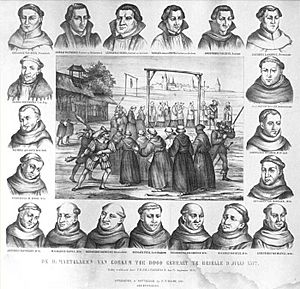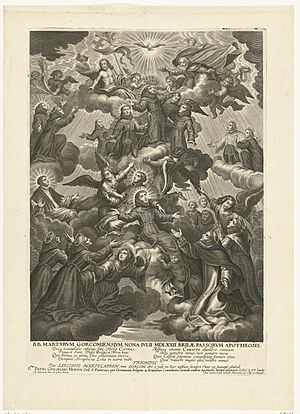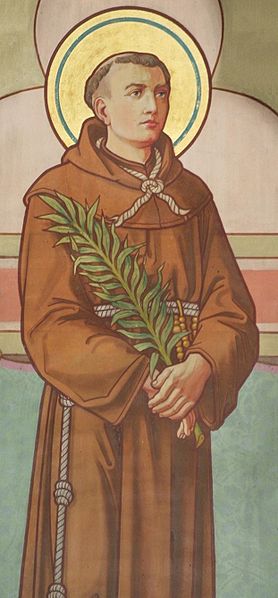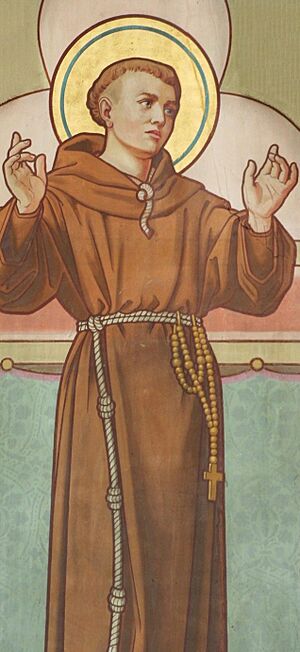Martyrs of Gorkum facts for kids
Quick facts for kids The Martyrs of Gorkum |
|
|---|---|

19 Martyrs of Gorcum
|
|
| Born | 16th century |
| Died | 9 July 1572, Brielle, County of Holland, Holy Roman Empire |
| Martyred by | The Watergeuzen |
| Means of martyrdom | hanging |
| Venerated in | Catholic Church (Netherlands and the Order of Friars Minor) |
| Beatified | 14 November 1675, Rome, Papal States, by Pope Clement X |
| Canonized | 29 June 1867, Rome, Papal States, by Pope Pius IX |
| Major shrine | Church of St. Nicholas, Brussels, Belgium |
| Feast | 9 July |
| Notable martyrs | Nicholas Pieck; Hieronymus of Weert; Theodorus van der Eem; Nicasius Janssen; Willehad of Denmark; Godefried of Mervel; Antonius of Weert; Antonius of Hoornaer; Franciscus de Roye of Brussels; Godefried van Duynsen of Gorkum, Joannes van Hoornaer, Jacobus Lacops of Oudenaar, Adrianus Janssen of Hilvarenbeek, Andreas Wouters of Heynoord and Joannes Lenartz of Oisterwijk |
The Martyrs of Gorkum (Dutch: Martelaren van Gorcum) were a group of 19 Dutch Catholic religious leaders. They were hanged on July 9, 1572, in the town of Brielle. This happened during the religious wars of the 1500s. Specifically, it was part of the Dutch Revolt against Spanish rule, which led to the Eighty Years' War.
Contents
The Story of the Martyrs
Religious Changes in Europe
In the early 1500s, new forms of Protestantism began to spread across Western Europe. Two main types were Lutheranism and Calvinism. The Low Countries, which are now the Netherlands and Belgium, were ruled by Spain.
The Spanish rulers, Emperor Charles V and his son King Philip II, tried to stop these new religious movements. This made many people unhappy with the government and the Catholic Church. In the northern parts of the Netherlands, people who were mostly Protestant started to turn against Catholic priests and monks.
The Dutch Revolt Begins
By 1572, the Netherlands was openly fighting against Spanish rule. Among the different Protestant groups, Calvinism became the strongest. On April 1, 1572, Calvinist fighters and a rebel group called the Watergeuzen (or Sea Beggars) captured the town of Brielle. Later, they also took Vlissingen.
In June, the towns of Dordrecht and Gorkum also fell to the rebels. In Gorkum, the rebels captured nine Franciscan priests. These included Nicholas Pieck, who was in charge of the Franciscans in Gorkum. Two lay brothers (religious men who are not priests) from the same group were also captured.
At the same time, the Calvinists arrested the main priest of Gorkum, Leonardus Vechel, and his helper. They also took Godefried van Duynsen, another priest from Gorkum, and Joannes Lenartz, a priest from a nearby monastery.
More Prisoners Join the Group
Later, four more people were added to this group of fifteen prisoners. One was Joannes van Hoornaer, a Dominican priest. He rushed to Gorkum to help the captured clergy but was arrested himself.
Another was Jacobus Lacops, a Norbertine priest. Adrianus Janssen, also a Norbertine priest, was sent to Brielle with Jacobus. The last one was Andreas Wouters.
Their Final Days
The first 15 prisoners were held in Gorkum from June 26 to July 6, 1572. Then, they were moved to Brielle, arriving on July 8. On their way, people paid money to see them.
The next day, William de la Marck, the leader of the Sea Beggars, questioned them. He demanded that they give up their Catholic beliefs. These beliefs included the idea that Christ is truly present in the Blessed Sacrament (called Transubstantiation). They also had to reject the Papal supremacy, which means the Pope is the head of the Church.
All the prisoners stayed strong in their faith. Meanwhile, a letter arrived from the Prince of Orange, William the Silent. This letter told everyone in charge to leave priests and religious people alone. But despite this order, on July 9, the 19 prisoners were hanged in a turfshed.
Honoring the Martyrs
Miracles and Recognition
It is said that a bush with 19 white flowers grew where the martyrs died. Many miracles have been linked to the prayers of the Gorkum Martyrs, especially healing hernias.
The martyrs were officially recognized as "blessed" (called beatification) on November 14, 1675. They were later declared saints (called canonization) on June 29, 1867. Their sainthood was announced during big celebrations. These celebrations marked 1,800 years since the traditional death of Saints Peter and Paul in Rome.
Pilgrimages and Relics
For many years, the place where they died in Brielle has been a site for pilgrimages. People visit and hold processions there. The special container holding their remains is now in the Church of Saint Nicholas in Brussels, Belgium.
The 19 Martyrs
Among the 19 people who died on July 9, 1572, there were:
- 11 Franciscan friars (also called Minderbroeders)
- 1 Dominican friar (or Predikheer)
- 2 Norbertine priests (called canons regular)
- 1 local canon regular (or witheren)
- 5 wereldheren (meaning secular clergy, priests who do not belong to a religious order)
The 19 martyrs were:
- Leonard van Veghel (born 1527), a secular priest and pastor of Gorkum.
- Peter of Assche (born 1530), a Franciscan lay brother.
- Andrew Wouters (born 1542), a secular priest and pastor of Heinenoord.
- Nicasius of Heeze (born 1522), a Franciscan friar, theologian, and priest.
- Jerome of Weert (born 1522), a Franciscan friar and priest in Gorcum.
- Anthony of Hoornaar, a Franciscan friar and priest.
- Godfried van Duynen (born 1502), a secular priest.
- Willehad of Denmark (born 1482), a Franciscan friar and priest.
- James Lacobs (born 1541), a Norbertine canon.
- Francis of Roye (born 1549), a Franciscan friar and priest.
- John of Cologne, a Dominican friar and pastor near Gorkum.
- Anthony of Weert (born 1523), a Franciscan friar and priest.
- Theodore of der Eem (born c. 1499–1502), a Franciscan friar and priest.
- Cornelius of Wijk bij Duurstede (born 1548), a Franciscan lay brother.
- Adrian van Hilvarenbeek (born 1528), a Norbertine canon and pastor.
- Godfried of Mervel (born 1512), a Franciscan priest and vicar.
- Jan of Oisterwijk (born 1504), an Augustinian canon regular and chaplain.
- Nicholas Poppel (born 1532), a secular priest and chaplain in Gorkum.
- Nicholas Pieck (born 1534), a Franciscan friar, priest, and leader of the friary in Gorkum.
See also
 In Spanish: Mártires de Gorcum para niños
In Spanish: Mártires de Gorcum para niños
- Stieltjeskerk
- Martyrs of Alkmaar
- Martyrs of Roermond




